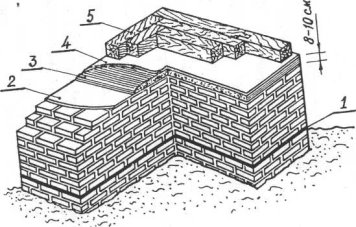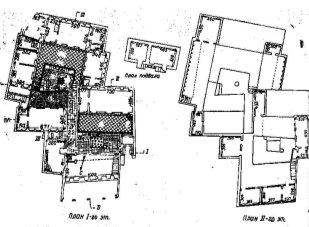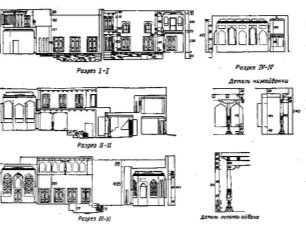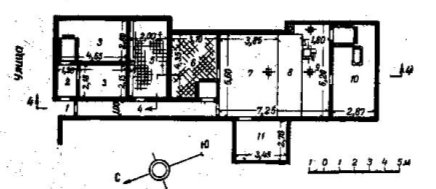Among the buildings of the XIX — beginning of the twentieth centuries, which have come down to us, residential houses are of particular value. In residential buildings, predominantly clay framework walls (wooden frame, wadding clay clods — guvala), the advantage of which — the undoubted cheapness and at the same time anti-seismicity. They also use raw and pahsovic walls, which are more economical, built of baked bricks and better keep cool in the summer, the heat of the lesions — in the winter.
Key words: ganch, ornament, decoration, aivans, terrace, veranda, guvala, crude brick, pahsovic, wall was made with clay.
The popular mass housing of Uzbekistan harbors centuries-old experience, it creates inner comfort and optimal living conditions in the zone of a sharply continental climate and increased seismicity.
The seismic protection methods used by ancient builders are found in the monuments of residential architecture, in particular, between the last row of brickwork and the overlaying masonry walls were laid earthen layers and reed belts, and on top of the trimming beams from the bars (Fig. 1).

Fig. 1. Seismic isolation device in the lower part of the walls of the buildings of Central Asia in the X-XV centuries: 1 and 4- skinny solution; 2-fat solution; 3 reed belt; 5 — binding from bars
The dwelling houses reflected the diversity of the artistic traditions of the population of the region, and therefore the motives of the carved ganch in Bukhara are different than in Samarkand; Khiva wooden columns are different from Bukhara; Namangan's painted ceilings are not the same as in Khiva, etc. [1]
Residential houses in Bukhara, the area of which was limited by the crowding of inner-city buildings, were erected mostly in two floors with one or two inner courtyards. Deaf facades covered the cozy organization of the inner space — the courtyard surrounded by aivans on wooden columns with stalactite capitals or carved with beams, the walls of the rooms richly decorated with figured kasamon niches, carved ganch, stucco moldings, and painted on the ceilings. [2]

Fig. 2. Bukhara House Abdu Khalik. Plans

Fig. 3. Bukhara House Abdu Khalik. Cuts
Samarkand houses were small in two or three rooms, with a column aivan, the walls of which, as well as the living room, were decorated with Kasamons, ganch carving with details or background painting. Samarkand kurgancha country estates, surrounded by a high adobe guvala, are peculiar. Their appearance resembles medieval fortresses due to decorative wattle and daub turrets, battlements, false loopholes; the surface of the pahsovic blocks is decorated with a notched or stamped pattern of linear geometric or symbolic-ornamental character. [2]
Khiva (hauli) town houses include a patio with two opposite aivans, (in one or two columns), which are surrounded by residential and commercial buildings. This method created vertical airing, which greatly reduced the temperature on hot days compared to the streets and squares of the city. Notable in them are carved doors, ceilings, columns. [2]

Fig. 4. Khiva Residential building near Tash Khauli. Plan
In the houses of the Fergana valley residential buildings are organically connected with the garden. The grape-trumpets entwined with grapes adjoin it, and in the system of the house itself, the kurgancha is remarkable — lifting or sliding frames with figured lattice filling, which regulate the thermal regime, lighting, ventilation and at the same time give features of great architectural expressiveness. [2]

Fig. 5. Fergana. House
The residence of Tashkent occupied, as it were, an intermediate position between the Samarkand and Fergana type of houses.
An analysis of the surviving dwellings of the types described above with the use of raw materials suggests that their constructive solution, inherited from their ancestors and past “approbation” during their centuries-old history and numerous earthquakes, may well withstand seismic influences with an intensity of 7–8 points [3].
Taking into account the existing reality and forecasts, the tendency to build houses from local soil materials will continue for a long time.
This is based on:
– that there are no transportation costs for their delivery to the construction site;
– for the preparation and processing of soil materials does not require significant energy costs and there are no harmful emissions that threaten the environment;
– there are no problems associated with recycling and use;
– clay materials have sufficient soundproofing properties, filter odors and help to maintain the optimum level of humidity in the rooms;
– clay materials are environmentally friendly and do not emit any substances harmful to health, do not cause allergic reactions and irritations;
– clay materials have such technological properties as plasticity, refractoriness, sintering, swelling, adsorption and binding capacity;
– elimination of shrinkage properties and cracking during drying, successfully achieved by the introduction of various kinds of fillers, additives and stabilizers;
– the same methods are achieved and fairly high rates of compressive strength (4.5 MPa and above).
References:
- Dmitriev V. M. Issues of using the architecture of the Uzbek national dwelling in modern practice. T.1980.
- Azimov I. Architectural monuments of the Fergana Valley. Т.1982.
- Sagdiev, Kh.S., Saidiy, A.A., Teshabaev, Z.R., Fasakhov, V. G. Engineering analysis of the effects of the earthquake of July 20, 2011. Problems in Mechanics, No. 22011, p. 8–12.







